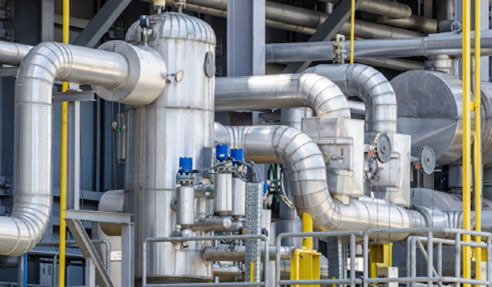Electric Heat Tracing Cables from Bellis Australia

Electric heat tracing is the application of heat to pipes, vessels, tanks, instruments and associated equipment to offset heat loss due to lower ambient temperature. Trace heating can be applied through several processes like electricity, glycol, hot oil, and steam. Electric heat tracing is a specific field of technology used for freeze protection (Winterization), to reduce product viscosity, prevent condensation and maintain the plant's production operations.
There are numerous industries where electric heat tracing can be used. The following are the possible applications for heat tracing or better known as electric heat tracing:
- Refinery and Petrochemical Process Plant
- Cryogenic and Liquefied Natural Gas terminals
- Power Generation Plant
- Mobile Tank Container Heating System
- Rail Heating System
- Building and Construction
The science and effectivity of electric heat tracing rely greatly on high-quality heating cables. These heating cables are considered to be the vital component of an electric heat tracing turnkey solution.
Constant Wattage Heating Cables with Resistance Wire
Constant wattage heating cables are designed for maintaining temperatures of up to +150°C or 302°F. The heating cable is equipped to withstand heat tracing in industrial refrigeration or in places with harsh climates. It is used for frost protection and temperature maintenance of pumps, vessels, pipelines and valves.

Constant wattage heating cables are flexible in nature - they can be easily cut to the required length off the roll, with the assurance of having a constant power output throughout the cable's length. It is easy to assemble and install as connecting cable isn't necessary and input can be unilateral.
Some of the advantages of using Constant Wattage Heating Cables are the following:
- Easily cut off from the roll
- Long life cycle
- UV and chemical resistance
- Single end power input
- Constant power output
Self-Regulating Heating Cables
Self-regulating heating cables are the most common parallel constructed heating cable. It incorporates two bus wires that are surrounded by a semi-conductive polymer matrix that contains high carbon content. Using a self-regulating heating cable eliminates the risk of hot or cold spots. As the temperature changes, the polymer expands and the distance between carbon particles also increases. This leads to an increase in the resistance and decreased watt output. When the temperature drops, the whole process is reversed and watt output increases.
Self-Regulating Heating Cables have the following benefits:
- Various temperature range applications
- Easy to assemble and install
- Can be cut off to the desired length
- Self-regulating with adjustable output
- Chemical resistant
Mineral Insulated (MI) Heating Cables
Mineral insulated heating cables are highly robust, mechanically stable, moisture-proof and non-flammable. They are suitable to use in applications where high wattage output and operating temperatures are required, like in the chemical and petrochemical industries. These heating cables are suitable for heating pipes, vessels, tank containers, flanges, valves. Mineral insulated cables can even be used in floors or concrete walls.
The following are some of the benefits of Mineral Insulated Heating Cable:
- Chemical resistant
- Airtight seal metal sheath
- Moisture-proof and can be immersed in fluids
- High operating temperatures with high watt output per meter
Electric heat tracing is a highly specialised field and requires the extensive knowledge of heat trace requirements and proper guidance from a qualified team of heat trace contractors.
Bellis Australia offers a broad spectrum of multifaceted services including electric heat tracing. Backed by decades of engineering and production experiences, Bellis is able to provide an optimised electric heat tracing solutions.
For an in-depth consultation on electric heat tracing and subsequent heating cables, contact Bellis Australia today.

|





 Pipe Insulation for Ductwork by Bellis
Pipe Insulation for Ductwork by Bellis Advantages of Pyrogel Aerogel Blanket
Advantages of Pyrogel Aerogel Blanket Marine Industry Skilled Labour Hire by
Marine Industry Skilled Labour Hire by Fibreglass Sleeving for Cable Protection
Fibreglass Sleeving for Cable Protection Protective Facade Materials for
Protective Facade Materials for Rockwool Partition Batts for
Rockwool Partition Batts for Benefits of Thermal Covers by Bellis
Benefits of Thermal Covers by Bellis Pre-Cladded Duct Insulation for Outdoor
Pre-Cladded Duct Insulation for Outdoor Fabric Expansion Joints for Round Ducts
Fabric Expansion Joints for Round Ducts Preformed Pipe Sections for Insulation
Preformed Pipe Sections for Insulation Storage Requirements for Versi-Foam
Storage Requirements for Versi-Foam Specialty Insulation Procurement QLD by
Specialty Insulation Procurement QLD by Advanced Fireproof Insulation Solutions
Advanced Fireproof Insulation Solutions Non-Combustible Insulation for High
Non-Combustible Insulation for High End Cap Gaskets for Piping by Bellis
End Cap Gaskets for Piping by Bellis Custom Sheet Metal Workers QLD by Bellis
Custom Sheet Metal Workers QLD by Bellis Aerogel Blanket for Flexible Insulation
Aerogel Blanket for Flexible Insulation Eco-Friendly Cleaner for Grill Plates by
Eco-Friendly Cleaner for Grill Plates by Advantages of Galvanised Steel Cladding
Advantages of Galvanised Steel Cladding Firemaster 550 Distributor QLD by Bellis
Firemaster 550 Distributor QLD by Bellis
